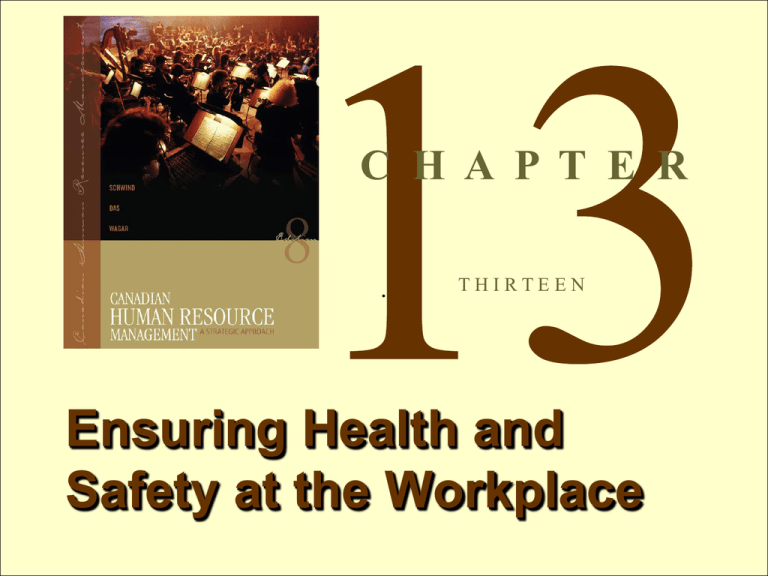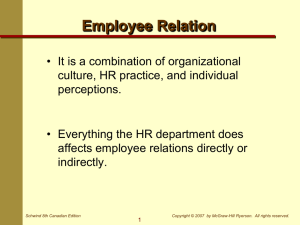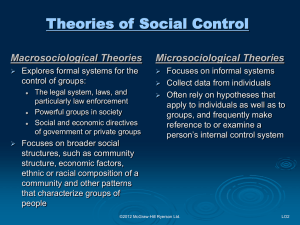
C H A P T E R
.
THIRTEEN
Ensuring Health and
Safety at the Workplace
Schwind 8th Canadian Edition
1
Copyright © 2007 by McGraw-Hill Ryerson. All rights reserved.
Schwind 8th Canadian Edition
2
Copyright © 2007 by McGraw-Hill Ryerson. All rights reserved.
Assumption of Risk
An obsolete attitude toward
accident prevention where the
worker accepted all the
customary risks and unsafe
practices
Schwind 8th Canadian Edition
3
Copyright © 2007 by McGraw-Hill Ryerson. All rights reserved.
Recognizing Hazards
Hazard – anything that can hurt you or make
you ill
Assessing hazards by learning 4 types
• Physical hazard: electricity, machinery parts,
ladders, liquids on the floor.
Schwind 8th Canadian Edition
4
Copyright © 2007 by McGraw-Hill Ryerson. All rights reserved.
Recognizing Hazards (cont.)
• Biological hazards: blood, body fluids,
plants, fungi, insect bites, bacteria,
viruses, animal droppings.
Schwind 8th Canadian Edition
5
Copyright © 2007 by McGraw-Hill Ryerson. All rights reserved.
Recognizing Hazards (cont.)
• Chemical hazards: cleaning products,
paint, acid, welding fume, flammable
materials, gas.
• Ergonomic hazards: poor lighting,
constant lifting, repeating the same
movements over and over, poor
workstation and chair.
Schwind 8th Canadian Edition
6
Copyright © 2007 by McGraw-Hill Ryerson. All rights reserved.
Safety in the Workplace Models
Careless Worker
Early approach to safety in the workplace
assuming accidents were due to workers’
carelessness
An approach to workplace safety that
relies on the cooperation of the employer
and employees
Shared Responsibility
Schwind 8th Canadian Edition
7
Copyright © 2007 by McGraw-Hill Ryerson. All rights reserved.
Health & Safety in the Workplace
• Growing emphasis on health and safety
in the workplace
– Strong union pressure
– Increased public interest in greater
corporate responsibility
• Better and more comprehensive federal
and provincial legislation and health and
safety measures
Schwind 8th Canadian Edition
8
Copyright © 2007 by McGraw-Hill Ryerson. All rights reserved.
Workplace Injuries
• Workplace accidents and occupationalrelated illnesses cost about $5 billion in
direct compensation (more than $10 billion
including indirect expenses) annually
• Work accidents are caused by a
combination of unsafe employee
behaviour and unsafe working conditions
Schwind 8th Canadian Edition
9
Copyright © 2007 by McGraw-Hill Ryerson. All rights reserved.
Health Hazards
Physical
agents
Biological
agents
Chemical
agents
Ergonomically
related
Exposure to
physical
elements
eg. noise
Exposure to
natural
organisms
eg. viruses
Exposure to
chemicals
or other
toxic
substances
Caused by
the work
environment
eg. repetitive
strain
Schwind 8th Canadian Edition
10
Copyright © 2007 by McGraw-Hill Ryerson. All rights reserved.
Younger Workers
• Growing emphasis on the health and
safety of young workers
• 1 in 7 young workers is injured on the job
• One-fourth of all workplace injuries
involve workers aged 15-29
Schwind 8th Canadian Edition
11
Copyright © 2007 by McGraw-Hill Ryerson. All rights reserved.
Federal and Provincial Regulations
• Each province and the Federal jurisdiction
have detailed legislation addressing
health and safety
• 3 Fundamental Employee Rights
– The right to know about workplace hazards
– The right to participate in correcting hazards
– The right to refuse dangerous work
Schwind 8th Canadian Edition
12
Copyright © 2007 by McGraw-Hill Ryerson. All rights reserved.
Joint OHS Committee
• Key element of health and safety laws
• Broad range of responsibilities:
– e.g. investigate & resolve complaints,
monitor health & safety programs, etc.
• Usually required in every workplace with
20 or more employees
Schwind 8th Canadian Edition
13
Copyright © 2007 by McGraw-Hill Ryerson. All rights reserved.
Schwind 8th Canadian Edition
14
Copyright © 2007 by McGraw-Hill Ryerson. All rights reserved.
Federal Laws
• Hazardous Products Act (1985)
– Protects consumers by regulating the sale of
dangerous products
• Workplace Hazardous Material
Information System - WHMIS (1988)
– Requires labels on all hazardous products
– Requires use of Material Safety Data Sheets
(MSDS)
• Safety Enforcement
Schwind 8th Canadian Edition
15
Copyright © 2007 by McGraw-Hill Ryerson. All rights reserved.
Responsibility for Health & Safety
Top
Management
Responsibility
for Health and
Safety
Supervisors
Employees
Schwind 8th Canadian Edition
16
Copyright © 2007 by McGraw-Hill Ryerson. All rights reserved.
Implications for HRM
• Consistent reinforcement & due diligence
– Ensure consistent enforcement of all safety and
health rules and all reasonable steps were taken
to avoid a particular health and safety offence
• Healthy and Safety Audit
• Safety Climate
– Commitment to safety
– HRM practices
– Local work group support & processes
Schwind 8th Canadian Edition
17
Copyright © 2007 by McGraw-Hill Ryerson. All rights reserved.
Schwind 8th Canadian Edition
18
Copyright © 2007 by McGraw-Hill Ryerson. All rights reserved.
Workplace Stress
• Workplace stress
– Harmful physical and emotional responses
• Stress management
– Ways of dealing with the problem of stress
• Conference Board of Canada
– Estimated financial cost associated with stress
in the Canadian workplace exceeds $12 billion
per year
Schwind 8th Canadian Edition
19
Copyright © 2007 by McGraw-Hill Ryerson. All rights reserved.
Symptoms of Stress
Nervousness, chronic worry
Easily provoked to anger
Depression, burnout
Symptoms
of Stress
Physical ailments
Cardiovascular disease
Injuries, suicide, cancer, ulcers
Schwind 8th Canadian Edition
20
Copyright © 2007 by McGraw-Hill Ryerson. All rights reserved.
Schwind 8th Canadian Edition
21
Copyright © 2007 by McGraw-Hill Ryerson. All rights reserved.
Major Causes of Workplace Stress
Factors unique • Workload, work pace, autonomy,
shift work, physical environment,
to job
isolation
Role in the
organization
• Role conflict/role ambiguity, level
of responsibility
Career
development
• Under or over-promotion, job
security, career development
opportunities, job satisfaction
more
Schwind 8th Canadian Edition
22
Copyright © 2007 by McGraw-Hill Ryerson. All rights reserved.
Major Causes of Workplace Stress
Relationships
at work
• Supervisors/co-workers and/or
subordinates, threat of violence
or harassment
Organizational • Level of participation in decisionmaking, management style,
climate
communication patterns
Schwind 8th Canadian Edition
23
Copyright © 2007 by McGraw-Hill Ryerson. All rights reserved.
Burnout
• Burnout
– Condition of mental, emotional, and sometimes
physical exhaustion that results form
substantial and prolonged stress
– Body is at work but mind is at home
HR Role: Human Resource department needs to be
proactive
– Help employees prevent burnout before it occurs
– Other preventative strategies e.g. job redesign
Schwind 8th Canadian Edition
24
Copyright © 2007 by McGraw-Hill Ryerson. All rights reserved.
Stress and Job performance
• Stress can be either helpful or harmful
No stress-----No Job challenges----performance tends to be low
Stress increases---performance tends increases
Stress becomes too great-----performance begins to decline
An employee loses the ability to cope and unable to make
decisions
Schwind 8th Canadian Edition
25
Copyright © 2007 by McGraw-Hill Ryerson. All rights reserved.
Stress Management
There are several solutions to manage
workplace stress:
• Curative measures
– Try to correct the outcome of stress e.g. yoga,
exercise program, counselling services
• Preventive measures
– Attempts to change the causes of stress e.g.
stress management training sessions,
improving working conditions
Schwind 8th Canadian Edition
26
Copyright © 2007 by McGraw-Hill Ryerson. All rights reserved.
Stress Management (cont.)
• Stress audit
– Identifies the causes of stress.
» Is job satisfaction low?
» Do interpersonal relations
contribute to the symptoms
described?
» Do career development variables
contribute to the symptoms
described?
Schwind 8th Canadian Edition
27
Copyright © 2007 by McGraw-Hill Ryerson. All rights reserved.
HR Actions to Reduce Stress
Compatible
workload
Establish
policy
Provide
training
Job design
Human Resource
Actions to Reduce
Stress
Work
schedules
Define roles
Participate in
decisions
Improve
communication
Schwind 8th Canadian Edition
28
Copyright © 2007 by McGraw-Hill Ryerson. All rights reserved.
Fitness & Employee Wellness
• Improve employee health
• Decrease health-care costs
• Improve employee satisfaction
• Decrease absenteeism and turnover
• Improve corporate image
Schwind 8th Canadian Edition
29
Copyright © 2007 by McGraw-Hill Ryerson. All rights reserved.
Other Contemporary Safety Issues
• Workplace Security - evacuation of building
• Sick Building Syndrome (SBS) – caused by
major combustion (very strong) pollutants such
as malfunctioning heating system, pesticides,
etc.
• Workplace Violence – to prevent incidents of
workplace violence ….. anti-violence policy,
zero-tolerance policy, self-defense training,
safety-security measures.
Schwind 8th Canadian Edition
30
Copyright © 2007 by McGraw-Hill Ryerson. All rights reserved.
Other Contemporary Safety
Issues (cont.)
• Ergonomics – proactive employers
provide safe work environment and
maintain employee privacy concerns.
Schwind 8th Canadian Edition
31
Copyright © 2007 by McGraw-Hill Ryerson. All rights reserved.
Other Contemporary Safety
Issues (cont.)
• AIDS
– policy regarding HIVinfected employee
– mandatory training for
managers,
supervisors and union
leaders
– education programs
for all employees
– counseling and
support
Schwind 8th Canadian Edition
32
Copyright © 2007 by McGraw-Hill Ryerson. All rights reserved.
C H A P T E R
.
THIRTEEN
Ensuring Health and
Safety at the Workplace
Schwind 8th Canadian Edition
33
Copyright © 2007 by McGraw-Hill Ryerson. All rights reserved.







